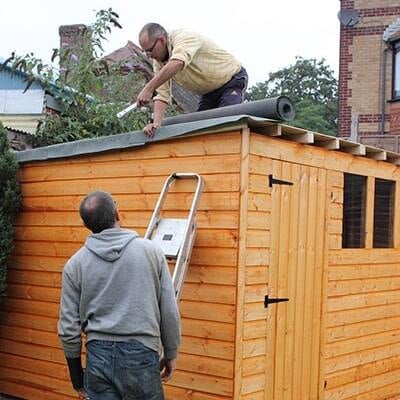Learn about Waterproofing Methods Suitable for Outbuilding Roofs
Introduction
Outbuildings are essential structures that serve various purposes, such as storage, workshops, or even extra living spaces. However, their roofs can often be prone to leaks and water damage. To protect your outbuilding and its contents, it is crucial to employ effective waterproofing methods. In this article, we will explore different techniques for waterproofing outbuilding roofs, including the application of waterproof membranes, sealants, and the installation of proper drainage systems.

I. Waterproof Membranes
One of the most common and effective methods for waterproofing outbuilding roofs is the application of waterproof membranes. These thin sheets are made from materials like bitumen or PVC and provide excellent protection against water infiltration. Here are some popular types of waterproof membranes:
-
Bituminous Membranes: Bituminous membranes are composed of asphalt or coal-tar pitch and are commonly used in outbuilding roofing. These membranes are flexible, easy to install, and have a strong resistance to water and UV rays.
-
PVC Membranes: PVC (Polyvinyl Chloride) membranes are another popular choice for outbuilding roofs. They are lightweight, durable, and have excellent resistance to chemicals, making them suitable for various applications.
-
EPDM Membranes: EPDM (Ethylene Propylene Diene Monomer) membranes are synthetic rubber sheets known for their durability and ability to withstand extreme weather conditions. They are highly stretchable, which allows for proper expansion and contraction with temperature variations.
-
TPO Membranes: TPO (Thermoplastic Olefin) membranes combine the benefits of PVC and EPDM. They are highly reflective, energy-efficient, and offer exceptional resistance to punctures, tears, and UV radiation.
To apply these membranes, start by preparing the roof surface, ensuring it is clean, dry, and free of any debris. Next, roll out the membrane onto the roof, ensuring it covers the entire surface. Secure the edges and seams using adhesive or heat welding, depending on the type of membrane being used.
II. Sealants
In addition to waterproof membranes, sealants are essential for providing an extra layer of protection against water intrusion. Sealants are typically used to seal joints, cracks, and gaps in the roof structure, preventing water from seeping through. Here are some common types of sealants suitable for outbuilding roofs:
-
Silicone Sealants: Silicone sealants are highly flexible and offer excellent adhesion to various materials. They can withstand extreme temperatures and have good resistance to UV rays, making them suitable for long-term use.
-
Acrylic Sealants: Acrylic sealants are easy to apply, cost-effective, and have good resistance to weathering and UV radiation. However, they may not be as flexible as silicone sealants.
-
Polyurethane Sealants: Polyurethane sealants are known for their high durability and excellent adhesion. They have strong resistance to weathering, UV rays, and chemicals, making them suitable for use in harsh environments.
Before applying sealants, ensure the roof surface is clean, dry, and free from dust and debris. Use a caulking gun or putty knife to apply the sealant evenly along the joints, cracks, and gaps. Smooth the sealant with a tool or your finger to ensure proper coverage.
III. Proper Drainage Systems
An effective drainage system is crucial for preventing water accumulation on your outbuilding roof. Without proper drainage, water can pool on the roof, leading to leaks, structural damage, and even collapse. Here are some essential components of a good drainage system:
-
Gutters: Install a gutter system along the edges of the roof to collect rainwater and direct it away from the building. Make sure the gutters are free from debris and properly sloped to allow for water flow.
-
Downspouts: Connect downspouts to the gutters to channel the collected water to the ground or a suitable drainage point. Ensure the downspouts are securely attached and positioned away from the foundation of the outbuilding.
-
Drainage Pipes: If your outbuilding has a flat roof, consider installing drainage pipes. These pipes are designed to collect and drain water from the roof surface. They should be properly installed with the appropriate slope to ensure water flow.
Inspect the drainage system regularly to remove any obstructions and ensure it is functioning correctly. Regular maintenance will prevent water from accumulating and ensure your outbuilding remains dry and protected.
FAQs
Q1. How often should I inspect the waterproofing of my outbuilding roof?
It is recommended to inspect your outbuilding roof for waterproofing issues at least once a year. However, if you notice any signs of water leakage or damage, it is advisable to conduct a thorough inspection immediately.
Q2. Can I apply waterproofing membranes and sealants myself, or should I hire a professional?
While it is possible to apply waterproofing membranes and sealants yourself, it is highly recommended to consult with a professional for the best results. Improper installation or application may lead to ineffective waterproofing and potential damage to your outbuilding.
Conclusion
Waterproofing your outbuilding roof is essential to safeguarding the structure and its contents against water damage. By utilizing waterproof membranes, sealants, and proper drainage systems, you can ensure that your outbuilding remains watertight and protected for years to come. Regular inspections and maintenance are crucial to address any potential leaks or issues promptly. Remember to consult with professionals to ensure the right methods and materials are used for your specific outbuilding roofing needs.

